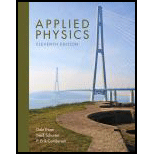
Applied Physics (11th Edition)
11th Edition
ISBN: 9780134159386
Author: Dale Ewen, Neill Schurter, Erik Gundersen
Publisher: PEARSON
expand_more
expand_more
format_list_bulleted
Concept explainers
Textbook Question
Chapter 21, Problem 21RQ
What types of images are formed by converging lenses?
Expert Solution & Answer
Want to see the full answer?
Check out a sample textbook solution
Chapter 21 Solutions
Applied Physics (11th Edition)
Ch. 21.5 - Given so = 1.65 cm and st = 6.00 cm, find f.Ch. 21.5 - Given f = 15.0 cm and st = 3.00 cm, find so.Ch. 21.5 - Given st = 14.5 cm and f = 10.0 cm, find so.Ch. 21.5 - Given st = - 10.0 cm and f = - 5.00 cm, find so.Ch. 21.5 - Given so = 7.35 cm and st = 17.0 cm, find f.Ch. 21.5 - Given ht = 2.75 cm, ho = 4.50 cm, and st = 6.00...Ch. 21.5 - Given ho = 12.0 cm, st = 13.0 cm, and so = 25.0...Ch. 21.5 - Given ht = 3.50 cm. hs = 2.50 cm, and st = 15.5...Ch. 21.5 - If an object is 2.50 m tall and 8.60 m from a...Ch. 21.5 - An object 30.0 cm tall is located 10.5 cm from a...
Ch. 21.5 - Prob. 11PCh. 21.5 - An object 12 6 cm in front of a convex mirror...Ch. 21.5 - What is the height of an image in a truck mirror...Ch. 21.5 - A lift truck has a rear view mirror that is 0.76 m...Ch. 21.5 - Find the focal length of a convex mirror that...Ch. 21.5 - Find the focal length of a mirror that forms an...Ch. 21.5 - Find the focal length of a mirror that forms an...Ch. 21.5 - An image of a statue appears to be 11.5 cm behind...Ch. 21.5 - (a) What is the height of a figurine 7.33 cm in...Ch. 21.10 - Find the index of refraction of a medium for which...Ch. 21.10 - Prob. 2PCh. 21.10 - If the index of refraction of a liquid is 1.50,...Ch. 21.10 - The angle of incidence of light passing from air...Ch. 21.10 - If the critical angle of a liquid is 42.4, find...Ch. 21.10 - If the index of refraction of a substance is 2.45,...Ch. 21.10 - A converging lens has a focal length of 15.0 cm....Ch. 21.10 - An object 2.50 cm tall is placed 20.0 cm from a...Ch. 21.10 - The focal length of a lens is 5.00 cm. How far...Ch. 21.10 - If the distance from the lens in your eye to the...Ch. 21.10 - An object 5.00 cm tall is placed 15.0 cm from a...Ch. 21.10 - An object 4.50 cm tall is placed 18.0 cm from a...Ch. 21.10 - What are the size and location of an image...Ch. 21.10 - What are the size and location of an image...Ch. 21.10 - What is the focal length of a convex lens that...Ch. 21 - Stained glass is an example of a. a transparent...Ch. 21 - A virtual image may be a. larger than the object....Ch. 21 - A real image may be a. erect. b. shown on a...Ch. 21 - Explain the difference between diffusion and...Ch. 21 - Prob. 5RQCh. 21 - Prob. 6RQCh. 21 - Describe the type of images formed by plane...Ch. 21 - Explain the difference between real and virtual...Ch. 21 - Explain the difference between a concave and a...Ch. 21 - Explain the effect of spherical aberration.Ch. 21 - For a mirror of given focal length, how does the...Ch. 21 - For a given object distance from a mirror, how...Ch. 21 - The index of refraction depends on a. the focal...Ch. 21 - Snell's law involves a. the lens equation. b. the...Ch. 21 - Prob. 15RQCh. 21 - Give several examples of total internal...Ch. 21 - Prob. 17RQCh. 21 - Prob. 18RQCh. 21 - Prob. 19RQCh. 21 - What types of images are formed by diverging...Ch. 21 - What types of images are formed by converging...Ch. 21 - How do water waves affect the escape of light from...Ch. 21 - Explain why a fish under water appears to be at a...Ch. 21 - Does light always travel in a straight line?...Ch. 21 - Explain how total internal reflection allows light...Ch. 21 - Under what conditions will a converging lens form...Ch. 21 - Under what conditions will a converging lens form...Ch. 21 - Under what conditions will a diverging lens form a...Ch. 21 - Using 1f=1s0+1si, s0 = 3.50 cm, and si = 7.25 cm,...Ch. 21 - Using 1f=1s0+1si, s0 = 8.50 cm, and f = 25.0 cm,...Ch. 21 - Using M=hih0=sis0, h0 = 6.50 cm, si = 7.50 cm, and...Ch. 21 - If an object is 3.75 m tall and 7.35 m from a...Ch. 21 - An object 43.0 cm tall is located 23.4 cm from a...Ch. 21 - Prob. 6RPCh. 21 - The angle of incidence of light passing from air...Ch. 21 - If the index of refraction of a liquid is 1.44,...Ch. 21 - If the critical angle of a liquid is 45.6, find...Ch. 21 - If the index of refraction of a substance is 1.50,...Ch. 21 - A converging lens has a focal length of 12.0 cm....Ch. 21 - An object 4.50 cm tall is placed 20.0 cm from a...Ch. 21 - The focal length of a lens is 4.00 cm. How far...Ch. 21 - What is the focal length of a convex lens that...Ch. 21 - What is the focal length of a mirror that forms an...Ch. 21 - What are the size and location of an image...Ch. 21 - What is the speed of light passing through a...Ch. 21 - Prob. 18RPCh. 21 - Find the focal length of a concave mirror with an...Ch. 21 - Prob. 20RPCh. 21 - Tamera uses a concave mirror when applying makeup....Ch. 21 - A convex security mirror has a radius of curvature...Ch. 21 - Prob. 3ACCh. 21 - Diamonds are cut to take advantage of internal...Ch. 21 - A photographer uses a 60.0-mm lens. (a) How far...
Additional Science Textbook Solutions
Find more solutions based on key concepts
Express the unit vectors in terms of (that is, derive Eq. 1.64). Check your answers several ways Also work o...
Introduction to Electrodynamics
The enthalpy of combustion of a gallon (3.8 liters) of gasoline is about 31,000 kcal. The enthalpy of combustio...
An Introduction to Thermal Physics
How is momentum related to the pressure exerted by a gas? Explain on the molecular level, considering the behav...
University Physics Volume 2
A typical person has a heart rate of 70 beats per minutes and takes 12 breaths in a minute. Show that her heart...
Conceptual Integrated Science
55. You’re 6.0 m from one wall of the house seen in FIGURE P4.55. You want to toss a ball to your friend who i...
Physics for Scientists and Engineers: A Strategic Approach with Modern Physics (4th Edition)
If capacitance is in F, what will he the units of the time constant RC when resistance is in (a) , (b) k, and (...
Essential University Physics: Volume 2 (3rd Edition)
Knowledge Booster
Learn more about
Need a deep-dive on the concept behind this application? Look no further. Learn more about this topic, physics and related others by exploring similar questions and additional content below.Similar questions
- What range of magnification is possible with a 7.0 cm-focal length converging lens?arrow_forwardA far-sighted person has a near point of 100 cm. How far in front or behind the retina does the image of an object placed 25 cm from the eye form? Use the cornea to retina distance of 25 cm.arrow_forwardWhat is the focal length of a magnifying glass that produces a magnification of 3.00 when held 5.00 cm from an object, such as a rare coin?arrow_forward
- A virtual image is always formed by a(n) ___ lens. (7.4)arrow_forwardIf you want your microscope or telescope to project a real image onto a screen, how would you change the placement of the eyepiece relative to the objective?arrow_forwardA concave mirror of radius of curvature 10 cm is placed 30 cm from a thin convex lens of focal length 15 cm. Find the location and magnification of a small bulb sitting 50 cm from the lens by using the algebraic method.arrow_forward
- Can you photograph a virtual image?arrow_forwardAn object of height 3.0 cm is placed 5.0 cm in front of a converging lens of focal length 20 cm and observed from the other side. Where and how large is the image?arrow_forwardA magnifying glass produces an angular magnification of 4.5 when used by a young person with a near point of 18 cm. What is the maximum angular magnification obtained by an older person with a near point of 45 cm?arrow_forward
- An object of height 3.0 cm is placed at 5.0 cm in front of a diverging lens of focal length 20 cm and observed from the other side. Where and how large is the image?arrow_forwardYou see the image of a sign through a camera obscura. The sign reads FOX AND SOX. Sketch the image.arrow_forwardWhat will be the angular magnification of a convex lens with the focal length 2.5 cm?arrow_forward
arrow_back_ios
SEE MORE QUESTIONS
arrow_forward_ios
Recommended textbooks for you
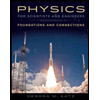 Physics for Scientists and Engineers: Foundations...PhysicsISBN:9781133939146Author:Katz, Debora M.Publisher:Cengage Learning
Physics for Scientists and Engineers: Foundations...PhysicsISBN:9781133939146Author:Katz, Debora M.Publisher:Cengage Learning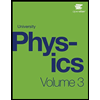 University Physics Volume 3PhysicsISBN:9781938168185Author:William Moebs, Jeff SannyPublisher:OpenStax
University Physics Volume 3PhysicsISBN:9781938168185Author:William Moebs, Jeff SannyPublisher:OpenStax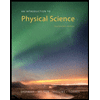 An Introduction to Physical SciencePhysicsISBN:9781305079137Author:James Shipman, Jerry D. Wilson, Charles A. Higgins, Omar TorresPublisher:Cengage Learning
An Introduction to Physical SciencePhysicsISBN:9781305079137Author:James Shipman, Jerry D. Wilson, Charles A. Higgins, Omar TorresPublisher:Cengage Learning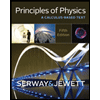 Principles of Physics: A Calculus-Based TextPhysicsISBN:9781133104261Author:Raymond A. Serway, John W. JewettPublisher:Cengage Learning
Principles of Physics: A Calculus-Based TextPhysicsISBN:9781133104261Author:Raymond A. Serway, John W. JewettPublisher:Cengage Learning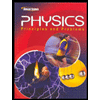 Glencoe Physics: Principles and Problems, Student...PhysicsISBN:9780078807213Author:Paul W. ZitzewitzPublisher:Glencoe/McGraw-Hill
Glencoe Physics: Principles and Problems, Student...PhysicsISBN:9780078807213Author:Paul W. ZitzewitzPublisher:Glencoe/McGraw-Hill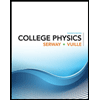 College PhysicsPhysicsISBN:9781305952300Author:Raymond A. Serway, Chris VuillePublisher:Cengage Learning
College PhysicsPhysicsISBN:9781305952300Author:Raymond A. Serway, Chris VuillePublisher:Cengage Learning

Physics for Scientists and Engineers: Foundations...
Physics
ISBN:9781133939146
Author:Katz, Debora M.
Publisher:Cengage Learning

University Physics Volume 3
Physics
ISBN:9781938168185
Author:William Moebs, Jeff Sanny
Publisher:OpenStax

An Introduction to Physical Science
Physics
ISBN:9781305079137
Author:James Shipman, Jerry D. Wilson, Charles A. Higgins, Omar Torres
Publisher:Cengage Learning

Principles of Physics: A Calculus-Based Text
Physics
ISBN:9781133104261
Author:Raymond A. Serway, John W. Jewett
Publisher:Cengage Learning

Glencoe Physics: Principles and Problems, Student...
Physics
ISBN:9780078807213
Author:Paul W. Zitzewitz
Publisher:Glencoe/McGraw-Hill

College Physics
Physics
ISBN:9781305952300
Author:Raymond A. Serway, Chris Vuille
Publisher:Cengage Learning
Convex and Concave Lenses; Author: Manocha Academy;https://www.youtube.com/watch?v=CJ6aB5ULqa0;License: Standard YouTube License, CC-BY